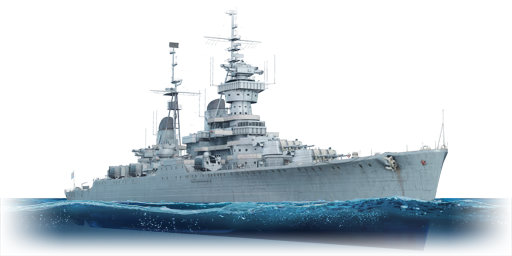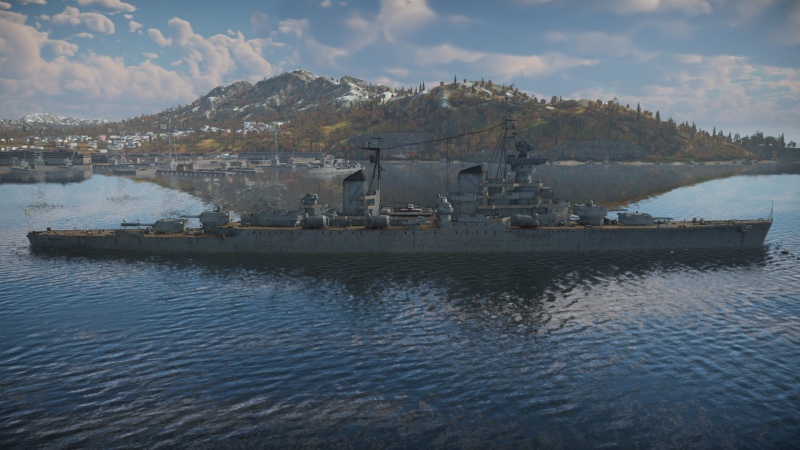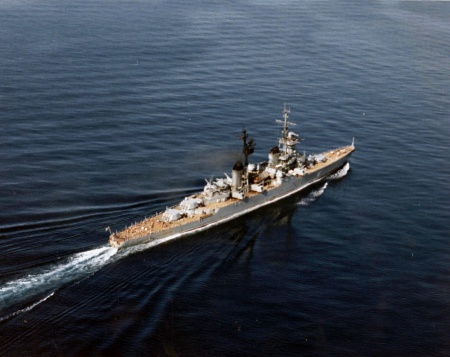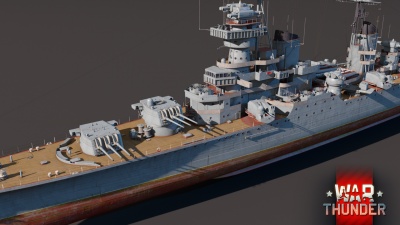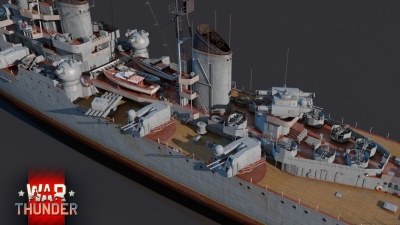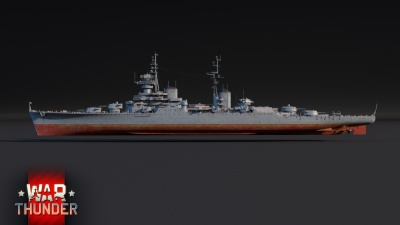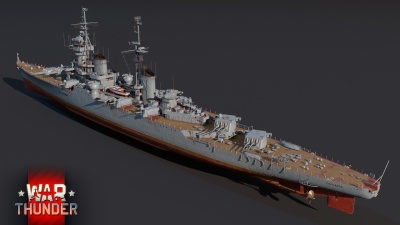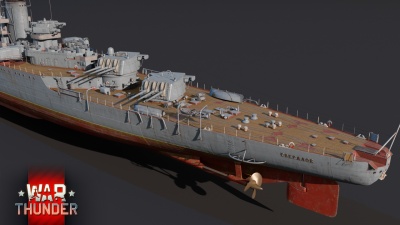Difference between revisions of "Sverdlov"
m |
(Improved the description of the vessel) (Tag: Visual edit) |
||
| Line 7: | Line 7: | ||
<!-- ''In the first part of the description, cover the history of the ship's creation and military application. In the second part, tell the reader about using this ship in the game. Add a screenshot: if a beginner player has a hard time remembering vehicles by name, a picture will help them identify the ship in question.'' --> | <!-- ''In the first part of the description, cover the history of the ship's creation and military application. In the second part, tell the reader about using this ship in the game. Add a screenshot: if a beginner player has a hard time remembering vehicles by name, a picture will help them identify the ship in question.'' --> | ||
The '''{{Specs|name}}''' is a rank {{Specs|rank}} Soviet light cruiser {{Battle-rating}}. It was introduced in [[Update 1.97 "Viking Fury"]]. | The '''{{Specs|name}}''' is a rank {{Specs|rank}} Soviet light cruiser {{Battle-rating}}. It was introduced in [[Update 1.97 "Viking Fury"]]. | ||
| + | |||
| + | The Sverdlov class of light cruisers were built in the USSR from the late 40s to late 50s and were the last purpose built big-gun cruisers ever created, as every other major navy was focusing on air power, submarines and missiles. They therefore represent the pinnacle of big-gun cruiser design, maintaining a great balance of speed, firepower, armour. The Sverdlov class was also fitted with an array of electronic systems, including numerous radars, which unfortunately are not yet modelled in game. | ||
== General info == | == General info == | ||
| Line 12: | Line 14: | ||
{{Specs-Fleet-Armour}} | {{Specs-Fleet-Armour}} | ||
<!-- ''Talk about the vehicle's armour. Note the most well-defended and most vulnerable zones, e.g. the ammo magazine. Evaluate the composition of components and assemblies responsible for movement and manoeuvrability. Evaluate the survivability of the primary and secondary armaments separately. Don't forget to mention the size of the crew, which plays an important role in fleet mechanics. Save tips on preserving survivability for the "Usage in battles" section. If necessary, use a graphical template to show the most well-protected or most vulnerable points in the armour.'' --> | <!-- ''Talk about the vehicle's armour. Note the most well-defended and most vulnerable zones, e.g. the ammo magazine. Evaluate the composition of components and assemblies responsible for movement and manoeuvrability. Evaluate the survivability of the primary and secondary armaments separately. Don't forget to mention the size of the crew, which plays an important role in fleet mechanics. Save tips on preserving survivability for the "Usage in battles" section. If necessary, use a graphical template to show the most well-protected or most vulnerable points in the armour.'' --> | ||
| − | While its armour is not enough to protect from high-calibre semi-armour-piercing and armour-piercing shells, it is still enough to prevent major damage from being easily inflicted by every shell that comes your way. | + | While its armour is not enough to protect from high-calibre semi-armour-piercing and armour-piercing shells, it is still enough to prevent major damage from being easily inflicted by every shell that comes your way. |
| + | |||
| + | HE from cruiser calibres or lesser should have trouble with anything below the main decks, as the main battery ammunition, engines, and transmissions are all protected by 100 mm of rolled homogeneous armour. The front and rear belt armour are only 20 mm and 30 mm thick RHA; while this isn't very useful, there is also not much in those areas that can be damaged besides the steering gear in the stern. The ammo elevators are protected by 130 mm RHA, while the turrets themselves have 175 mm on the turret face, making them some of the most heavily armoured cruiser turret faces in game. The turret sides and rear are much thinner but this isn't a major problem as long as the main batteries are kept pointed towards the enemy. Secondary batteries have 20 mm thick antifragmentation armour, which is only useful against smaller autocannons and strafing aircraft. Anti-aircraft batteries have no armour at all and are often knocked out. The conning tower has 130mm of armour surrounding it, but the roof and floor are considerably thinner, meaning the bridge can still be knocked out by rounds exploding above and below it. | ||
| + | |||
| + | As an aside, like any other ship, the Sverdlov's armour is most effective when angled and in order to angle the ship as sharply as possible while keeping all main cannons on target, you'll have to point the bow of the vessel away from the enemy. | ||
| + | |||
| + | It should go without saying that any fire coming at you from capital ships can and will ruin your day , your armour is in no way capable of resisting even 283mm shells. | ||
=== Mobility === | === Mobility === | ||
| Line 18: | Line 26: | ||
<!-- ''Write about the ship's mobility. Evaluate its power and manoeuvrability, rudder rerouting speed, stopping speed at full tilt, with its maximum forward and reverse speed.'' --> | <!-- ''Write about the ship's mobility. Evaluate its power and manoeuvrability, rudder rerouting speed, stopping speed at full tilt, with its maximum forward and reverse speed.'' --> | ||
| − | The Sverdlov, | + | The Sverdlov, like its predecessors [[Chapayev]] and [[Zheleznyakov]], is a cruiser that feels like almost like a destroyer. It is fast for a cruiser of its size, its 61km/h top speed being quite impressive for a cruiser that weighs almost as much as a dreadnought. The vessel is fairly responsive and agile, although that may be a detriment at times as the ship will keel to the side as you turn, sometimes keeling far enough to prevent you from targeting enemies on one side of the ship. |
{{NavalMobility}} | {{NavalMobility}} | ||
| Line 32: | Line 40: | ||
{{main|152 mm/57 B-38 (152 mm)}} | {{main|152 mm/57 B-38 (152 mm)}} | ||
| − | The Sverdlov is | + | The Sverdlov is another Soviet cruiser to be armed with the formidable 152 mm/57 B-38, which are potent and powerful fast-firing cannons. The 152mm has access to four types of ammunition: '''HE''', '''SAP''', '''AP''' and '''HE'''-'''TF'''. |
| + | |||
| + | The HE shell has good explosive filler for a 152mm shell, with 6kg in total. Effective against coastal vessels, the hitting power falls away significantly against cruisers. While it can still be useful for starting fires and destroying unarmoured modules, is otherwise rather useless against anything larger than a destroyer. | ||
| + | |||
| + | The SAP shell is particularly useful as it has practically just as much explosive filler as your HE shell, but has quite decent penetration statistics as well. Due to the current meta of explosive power trumping penetrative power, this makes your SAP shell highly useful against both cruisers and destroyers. | ||
| + | |||
| + | The AP shell is a more situational shell. While having considerably more penetrative power than your SAP shell, the explosive filler is much much less. Given that the War Thunder damage system uses crew members to function as a health bar and that fights often occur at much closer ranges than real life, the SAP shell will simply be able to knock out more crew with each hit against most targets compared to if you use AP. However, it can still be useful for targeting specific components or for the rare occasions you encounter a cruiser too heavily armoured for your SAP. | ||
| + | |||
| + | The TF shell is basically your HE shell but with slightly more explosive filler and with a timed fuse, intended for use against aircraft. It is utterly useless against surface targets, don't even try use it in this role. Due to being a timed fuse and not VT like the 100mm shells, it's not as reliable as you might want, plus the relatively slow traverse speed on the main turrets make this one of the less useful shells you have access to. I'd advise not bothering to bring any during a regular battle. | ||
| + | |||
| + | As a note, non of your shells are capable of dealing with battleships. Do not attract the attention of one unless necessary or at extremely close range, where you might just be able to do damage to them. | ||
=== Secondary armament === | === Secondary armament === | ||
| Line 39: | Line 57: | ||
{{main|100 mm/70 SM-5-1 (100 mm)}} | {{main|100 mm/70 SM-5-1 (100 mm)}} | ||
| − | The Sverdlov is the second of the Soviet cruisers with access to 100 mm/70 SM-5-1. While these turrets are very similar to the [[130 mm/58 SM-2-1 (130 mm)|130 mm/58 SM-2-1]], they do have reduced performance due to the smaller calibre. | + | The Sverdlov is the second of the Soviet cruisers with access to the dual purpose 100 mm/70 SM-5-1. While these turrets are very similar to the [[130 mm/58 SM-2-1 (130 mm)|130 mm/58 SM-2-1]] of the [[Spokoinyy|Spokoinyy,]] they do have reduced performance due to the smaller calibre. However, you have 12 of them. |
| + | |||
| + | It is nothing new that this weapon system has a very high ROF for its calibre (roughly ~30 RPM considering it is a two cannon mount), though it has half of what cannons like the [[100 mm/55 MLE model 53 (100 mm)]] have (~60 RPM). | ||
| − | + | Although they are a fine patrol boat deterrent, you'll get the most use out of these turrets as heavy AA. The previous [[Chapayev]] class already had great AA capabilities with these cannons and now you have 4 more of them than the Chapayev class. Compared to the [[Chapayev]], you have a combined fire rate of ~180 RPM, which is ~60 RPM more than the Chapayev. With HE-VT shells, this puts up a formidable screen of air-bursting shells in the face of inbound aircraft. | |
=== Anti-aircraft armament === | === Anti-aircraft armament === | ||
| Line 55: | Line 75: | ||
{{main|53-39 (533 mm)}} | {{main|53-39 (533 mm)}} | ||
| − | Unlike the | + | Unlike the Pr.68K cruisers, the Pr.68bis Sverdlov is the only one with access to torpedo tubes. It is armed with 2 x 5-tube torpedo launchers, one located at port and the other at starboard. It uses the 53-39 533 mm torpedo. Being torpedoes, they are highly situational, but do offer the possibility of you being able to take out much more heavily armoured opponents, like battleships, should you get one on target. They have a max range of 4 km (10 km with the torpedo mode modification) and can be used at almost point blank, the torpedo must travel 50 m at minimum to be armed. These torpedoes are one of the fastest ones seen at the battle rating (94 km/h), making it easier to aim at long ranges. However, the speed is drastically reduced if torpedo mode is active as it trades speed for range. |
== Usage in battles == | == Usage in battles == | ||
<!-- ''Describe the technique of using this ship, the characteristics of her use in a team and tips on strategy. Abstain from writing an entire guide – don't try to provide a single point of view, but give the reader food for thought. Talk about the most dangerous opponents for this vehicle and provide recommendations on fighting them. If necessary, note the specifics of playing with this vehicle in various modes (AB, RB, SB).'' --> | <!-- ''Describe the technique of using this ship, the characteristics of her use in a team and tips on strategy. Abstain from writing an entire guide – don't try to provide a single point of view, but give the reader food for thought. Talk about the most dangerous opponents for this vehicle and provide recommendations on fighting them. If necessary, note the specifics of playing with this vehicle in various modes (AB, RB, SB).'' --> | ||
| − | The Sverdlov is a Chapayev but better | + | The Sverdlov is simply a Chapayev, but better. The potent firepower is enough to destroy a wide variety of targets but to also provide a very devastating and powerful AA coverage to allied ships, especially at long range. The Sverdlov can be used as a brawler when in CQC maps, although not recommended, it is very capable of doing so. The armour and firepower it carries is enough to match practically any cruiser you can meet in a duel. |
=== Pros and cons === | === Pros and cons === | ||
| Line 67: | Line 87: | ||
* Very effective AA suite with 100 mm VT shells and 37 mm automatic guns | * Very effective AA suite with 100 mm VT shells and 37 mm automatic guns | ||
| − | * | + | * Effective armour |
| − | * 12 x 152 mm cannons with | + | * 12 x 152 mm cannons with highly effective ammunition |
'''Cons:''' | '''Cons:''' | ||
| − | * | + | * Lots of AA mounts which can be destroyed by HE splash. |
* After exhausting the first-stage storage of the main guns, the reload speed is significantly reduced | * After exhausting the first-stage storage of the main guns, the reload speed is significantly reduced | ||
* If the torpedoes are loaded they can cause an explosion if they are hit, disabling or even sinking the ship | * If the torpedoes are loaded they can cause an explosion if they are hit, disabling or even sinking the ship | ||
Revision as of 15:05, 1 March 2022
Contents
Description
The Pr.68-bis, Sverdlov, 1952 is a rank Soviet light cruiser with a battle rating of (AB), (RB), and (SB). It was introduced in Update 1.97 "Viking Fury".
The Sverdlov class of light cruisers were built in the USSR from the late 40s to late 50s and were the last purpose built big-gun cruisers ever created, as every other major navy was focusing on air power, submarines and missiles. They therefore represent the pinnacle of big-gun cruiser design, maintaining a great balance of speed, firepower, armour. The Sverdlov class was also fitted with an array of electronic systems, including numerous radars, which unfortunately are not yet modelled in game.
General info
Survivability and armour
While its armour is not enough to protect from high-calibre semi-armour-piercing and armour-piercing shells, it is still enough to prevent major damage from being easily inflicted by every shell that comes your way.
HE from cruiser calibres or lesser should have trouble with anything below the main decks, as the main battery ammunition, engines, and transmissions are all protected by 100 mm of rolled homogeneous armour. The front and rear belt armour are only 20 mm and 30 mm thick RHA; while this isn't very useful, there is also not much in those areas that can be damaged besides the steering gear in the stern. The ammo elevators are protected by 130 mm RHA, while the turrets themselves have 175 mm on the turret face, making them some of the most heavily armoured cruiser turret faces in game. The turret sides and rear are much thinner but this isn't a major problem as long as the main batteries are kept pointed towards the enemy. Secondary batteries have 20 mm thick antifragmentation armour, which is only useful against smaller autocannons and strafing aircraft. Anti-aircraft batteries have no armour at all and are often knocked out. The conning tower has 130mm of armour surrounding it, but the roof and floor are considerably thinner, meaning the bridge can still be knocked out by rounds exploding above and below it.
As an aside, like any other ship, the Sverdlov's armour is most effective when angled and in order to angle the ship as sharply as possible while keeping all main cannons on target, you'll have to point the bow of the vessel away from the enemy.
It should go without saying that any fire coming at you from capital ships can and will ruin your day , your armour is in no way capable of resisting even 283mm shells.
Mobility
The Sverdlov, like its predecessors Chapayev and Zheleznyakov, is a cruiser that feels like almost like a destroyer. It is fast for a cruiser of its size, its 61km/h top speed being quite impressive for a cruiser that weighs almost as much as a dreadnought. The vessel is fairly responsive and agile, although that may be a detriment at times as the ship will keel to the side as you turn, sometimes keeling far enough to prevent you from targeting enemies on one side of the ship.
| Mobility Characteristics | |||
|---|---|---|---|
| Game Mode | Upgrade Status | Maximum Speed (km/h) | |
| Forward | Reverse | ||
| AB | |||
| Upgraded | |||
| RB/SB | |||
| Upgraded | |||
Modifications and economy
Armament
Primary armament
The Sverdlov is another Soviet cruiser to be armed with the formidable 152 mm/57 B-38, which are potent and powerful fast-firing cannons. The 152mm has access to four types of ammunition: HE, SAP, AP and HE-TF.
The HE shell has good explosive filler for a 152mm shell, with 6kg in total. Effective against coastal vessels, the hitting power falls away significantly against cruisers. While it can still be useful for starting fires and destroying unarmoured modules, is otherwise rather useless against anything larger than a destroyer.
The SAP shell is particularly useful as it has practically just as much explosive filler as your HE shell, but has quite decent penetration statistics as well. Due to the current meta of explosive power trumping penetrative power, this makes your SAP shell highly useful against both cruisers and destroyers.
The AP shell is a more situational shell. While having considerably more penetrative power than your SAP shell, the explosive filler is much much less. Given that the War Thunder damage system uses crew members to function as a health bar and that fights often occur at much closer ranges than real life, the SAP shell will simply be able to knock out more crew with each hit against most targets compared to if you use AP. However, it can still be useful for targeting specific components or for the rare occasions you encounter a cruiser too heavily armoured for your SAP.
The TF shell is basically your HE shell but with slightly more explosive filler and with a timed fuse, intended for use against aircraft. It is utterly useless against surface targets, don't even try use it in this role. Due to being a timed fuse and not VT like the 100mm shells, it's not as reliable as you might want, plus the relatively slow traverse speed on the main turrets make this one of the less useful shells you have access to. I'd advise not bothering to bring any during a regular battle.
As a note, non of your shells are capable of dealing with battleships. Do not attract the attention of one unless necessary or at extremely close range, where you might just be able to do damage to them.
Secondary armament
The Sverdlov is the second of the Soviet cruisers with access to the dual purpose 100 mm/70 SM-5-1. While these turrets are very similar to the 130 mm/58 SM-2-1 of the Spokoinyy, they do have reduced performance due to the smaller calibre. However, you have 12 of them.
It is nothing new that this weapon system has a very high ROF for its calibre (roughly ~30 RPM considering it is a two cannon mount), though it has half of what cannons like the 100 mm/55 MLE model 53 (100 mm) have (~60 RPM).
Although they are a fine patrol boat deterrent, you'll get the most use out of these turrets as heavy AA. The previous Chapayev class already had great AA capabilities with these cannons and now you have 4 more of them than the Chapayev class. Compared to the Chapayev, you have a combined fire rate of ~180 RPM, which is ~60 RPM more than the Chapayev. With HE-VT shells, this puts up a formidable screen of air-bursting shells in the face of inbound aircraft.
Anti-aircraft armament
As already seen in previous Soviet vessels, 37 mm autocannons are a must have. However, Sverdlov takes the 37 mm to the next level. Previous ships tended to have between 6-10 single mount 37 mm autocannons. This was changed with the Chapayev with making double mounts, increasing the number of 37 mm barrels to 28, which the Sverdlov further increases to 32.
Additional armament
Unlike the Pr.68K cruisers, the Pr.68bis Sverdlov is the only one with access to torpedo tubes. It is armed with 2 x 5-tube torpedo launchers, one located at port and the other at starboard. It uses the 53-39 533 mm torpedo. Being torpedoes, they are highly situational, but do offer the possibility of you being able to take out much more heavily armoured opponents, like battleships, should you get one on target. They have a max range of 4 km (10 km with the torpedo mode modification) and can be used at almost point blank, the torpedo must travel 50 m at minimum to be armed. These torpedoes are one of the fastest ones seen at the battle rating (94 km/h), making it easier to aim at long ranges. However, the speed is drastically reduced if torpedo mode is active as it trades speed for range.
Usage in battles
The Sverdlov is simply a Chapayev, but better. The potent firepower is enough to destroy a wide variety of targets but to also provide a very devastating and powerful AA coverage to allied ships, especially at long range. The Sverdlov can be used as a brawler when in CQC maps, although not recommended, it is very capable of doing so. The armour and firepower it carries is enough to match practically any cruiser you can meet in a duel.
Pros and cons
Pros:
- Very effective AA suite with 100 mm VT shells and 37 mm automatic guns
- Effective armour
- 12 x 152 mm cannons with highly effective ammunition
Cons:
- Lots of AA mounts which can be destroyed by HE splash.
- After exhausting the first-stage storage of the main guns, the reload speed is significantly reduced
- If the torpedoes are loaded they can cause an explosion if they are hit, disabling or even sinking the ship
History
The Soviet cruiser Sverdlov was the lead ship of the Sverdlov class of light cruisers built for the Soviet navy in the 1950s. Being conventional cruisers, they were designed to function as bluewater ships with the ability to perform commerce raiding duties if required, similar to the German pocket battleships and battlecruisers. The ships inherited the hulls of the previous Chapayev class, but carried an improved armament and new sensor systems. Sverdlov was commissioned in 1952, and spent most of her operational career making visits to various foreign ports and countries. She was eventually retired in the late 1970s and scrapped shortly before the collapse of the Soviet Union.
Design and development
After the construction of the Chapayev class (Project 68), the Soviet Union began the development of an improved iteration of the ship, to be known as the Sverdlov class or Project 68bis. A total of 40 ships were intended to be built, along with the larger Stalingrad-class battlecruisers and Soviet aircraft carriers. As well, the ships were intended to be capable of commerce raiding, as shown by the conspicuous success of the German commerce raiders during World War II. As a result, the ships were the largest cruisers ever built by the Soviet navy up to that time (and largest until the introduction of the Kirov-class battlecruisers), displacing 16 640 tons. Because the Soviet Leader Stalin had been a supporter of the program, his death in 1953 saw the total number of ships cut to 14. The lead ship, Sverdlov, was laid down in October of 1949 and completed by May of 1952.
Sverdlov displaced 16 640 tons full and had a crew complement of 1250 officers and men. Her main armament consisted of twelve 6-inch (152 mm) guns in four triple turrets, similar to the British Crown Colony-class and American Cleveland-class. Despite this, the Sverdlovs were still inferior in armament to the American Baltimore-class and Des Moines-class cruisers that were then in service. The ships had a heavy anti-aircraft battery of twelve 100 mm guns in twin turrets, and 32 37 mm anti-aircraft guns in twin turrets. The ships also carried two quintuple torpedo tubes on their beam. Powered by steam turbines developing 118 000 shaft horsepower, the Sverdlov could make 32.5 knots (60 km/h) and had a range of 9000 nautical miles.
Operational history
The Sverdlov joined the Soviet 4th Fleet in 1952 after her commissioning, and soon after attended the coronation review of Queen Elizabeth II at Portsmouth. Soon after, she visited Portsmouth again as well as the Dutch port of Rotterdam. She received a major overhaul in 1960 before being laid up and decommissioned. In 1972, she was reactivated again, and visited several European ports before being retired one final time in 1978. By this time, the gun-cruiser nature of the Sverdlovs had made them highly obsolete. As a result, she was sold to an Indian ship-breaker company in 1991, and scrapped by 1993. Out of all the Sverdlov-class cruisers, only Mikhail Kutuzov survives to this day as a museum ship.
Devblog
The Project 68bis light cruisers were a serious modernisation of the Project 68K ships (one of which, the Chapaev light cruiser, you know well). The essence of all planned improvements was simple: to apply all the accumulated military experience and technical achievements as soon as possible to make the light cruisers better in every way. In the course of the modernisation process, the anti-air weaponry was significantly improved, torpedo armament was added, and the armour and stability of the ships were upgraded. The engineers paid special attention to the protection for the crew, which was increased, by the way. All uncovered battle stations received armour or some other kind of protection, and it became possible to move from bow to rear without going out onto the open sections of the deck.
The height of the freeboard increased, which provided ships of this class with better weather resistance and greater range. In keeping with the changes to the naval warfare doctrine, the Project 68bis light cruiser benefited from significant self-sustainment of up to 30 days, and also its sailing range was increased to 9,000 miles. The need for these improvements was so great that the building of the first Project 68bis light cruisers had begun even before the complete project documentation was agreed upon. The leading ship of the series, the Sverdlov, was launched in the summer of 1950, and a short while later, she was put into service as a part of the Baltic Fleet. The Sverdlov light cruiser carried out combat duties in the waters of the Baltic Sea and Atlantic Ocean until her lay-up in 1978. In 1989, the ship was removed from storage, disarmed, and sold to India for scrap metal.
Media
See also
Links to articles on the War Thunder Wiki that you think will be useful for the reader, for example:
- reference to the series of the ship;
- links to approximate analogues of other nations and research trees.
External links
References
- Clarke, A. (2018, June 01). Sverdlov Class Cruisers, and the Royal Navy's Response. Retrieved January 20, 2021, from http://globalmaritimehistory.com/sverdlov_class_rn_response/
| Baltic Shipyard (Балтийский завод) | |
|---|---|
| Light Cruisers | |
| Svetlana-class | Krasny Krym* |
| Project 26/26bis | Kirov · Maxim Gorky |
| Project 68 | Chapayev |
| Project 68bis | Sverdlov |
| Battlecruisers | |
| Izmail-class | Izmail |
| Battleships | |
| Sevastopol-class | Marat · Parizhskaya Kommuna |
| *Laid down at the Russian-Baltic shipyard in Tallinn | |
| USSR light cruisers | |
|---|---|
| Imperial Russia | |
| Svetlana-class | Krasny Krym* · Krasny Kavkaz* |
| * Laid down by Imperial Russian Navy; Finished and renamed by the USSR | |
| Project | Soviet Union |
| Pr.26 | Kirov · Voroshilov · Maxim Gorky |
| Pr.68 | Chapayev · Zheleznyakov |
| Pr.68-bis | Sverdlov · Mikhail Kutuzov |
| Pr.68-bis-ZiF | Shcherbakov |
| Lend-Lease | USA |
| Omaha-class | Murmansk |
| Trophies | Italy |
| Condottieri-class | Kerch |


